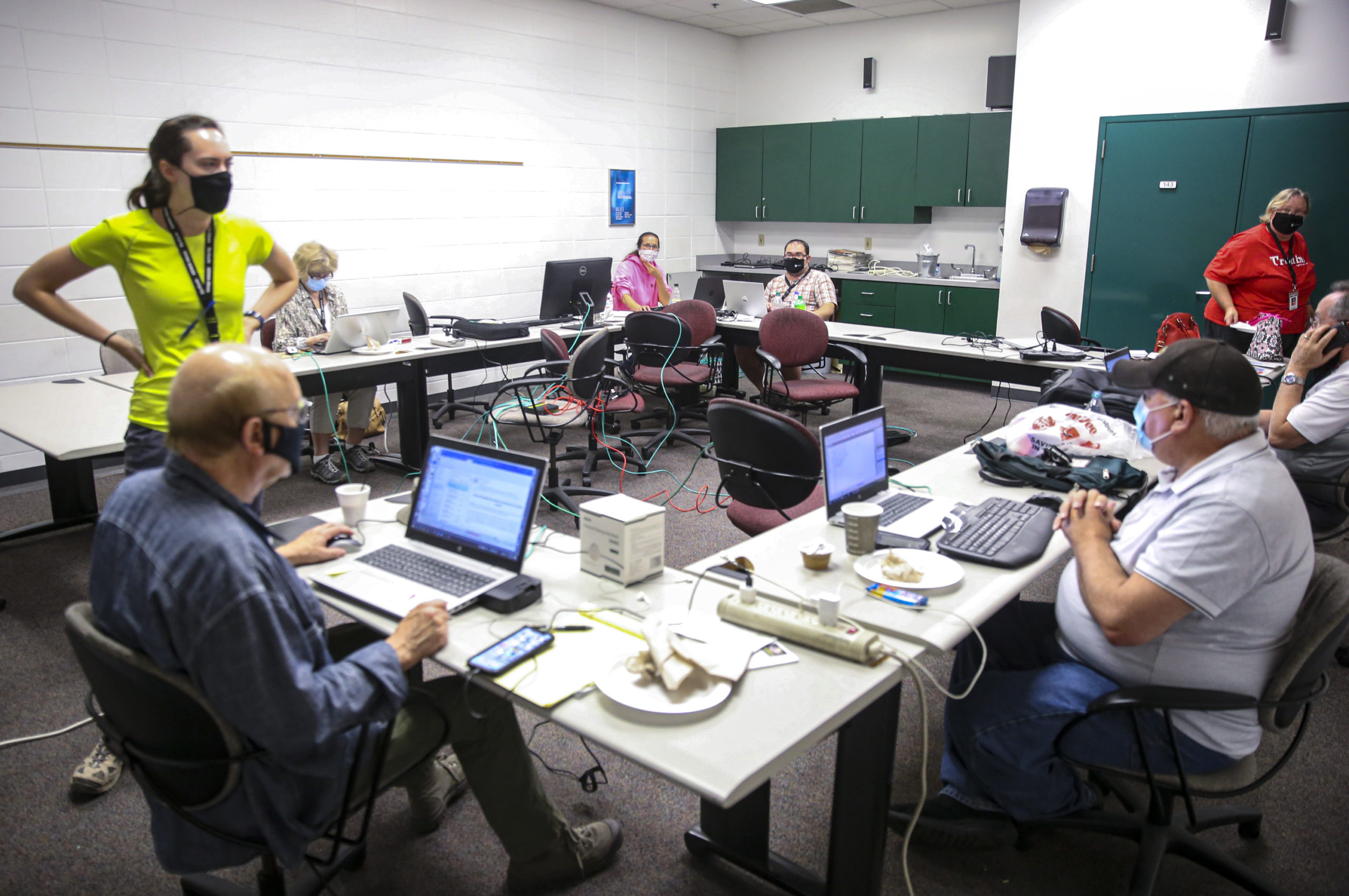This piece originally appeared in Local Edition, our newsletter devoted to the telling stories of local journalists. Want to be part of the conversation? You can subscribe here.
The news broke everything. Well, almost everything.
Last Monday, on a clear, sunny morning, about 10 newsroom leaders from The (Cedar Rapids) Gazette were touring the future home of their newsroom when the sky turned black, the winds turned violent and objects started flying.
They tried not to watch, to hide in the hallway. But through the two-story picture window looking out on downtown, executive editor Zack Kucharski spied swirling streetlights, ripped off roofs and street signs 40 feet in the air.
This is not his first natural disaster.
Kucharski has worked at The Gazette since 2000. That newsroom covered a 2006 tornado in Iowa City, flooding in 2008 and a close call in 2016.
“I’ve been very close to tornadoes,” Kucharski said, “and the derecho is different.”
That derecho, which hit with the force of a Category 2 hurricane, has left four dead, homes in shambles, the county without power, and a newsroom of 70 who’ve learned to work remotely in a pandemic with a new challenge.
How do you cover a crisis like this during the coronavirus?
I was stuck on Interstate 380 yesterday when the derecho storm struck eastern Iowa bringing winds in excess of 100mph. In about 5 miles I saw 7 trucks turned on their side by wind. I stopped to offer help as 2 drivers were pulled from their cabs, both without apparent injury. pic.twitter.com/YrHeY0YtAc
— Andy Abeyta (@andy_abeyta) August 11, 2020
Kucharski figured another newsroom would be the first to cover a natural disaster in the middle of a pandemic. But editors in Cedar Rapids had one unplanned advantage — they just happened to physically be together when the derecho swept through.
“If we had all been in our houses, to track each other down, we would have lost time,” he said. “And we knew that we had a big story.”
For the first few hours, cell phones still worked and editors were able to reach staff. They relocated to the printing facility, which had some roof damage but a functioning generator. The internet was out.
The Gazette team started pulling together the news and laying out the next day’s newspaper on a table by the server room. They connected five computers to the network and took turns producing the paper.
They couldn’t access the wires, email or the internet, but 30 miles away, the Iowa City bureau had a connection. One staffer drove there and started pulling pieces of the news, putting them on a thumb drive and heading back to Cedar Rapids to get them on the page, Kucharski said.
“And so we were running them up and down the interstate to keep things going.”

From Madison, Wisconsin, Molly Duffy watched journalists in Cedar Rapids tweet what was happening during the storm and in the days that followed.
Duffy’s last day at The Gazette was the Friday before the derecho hit. A week later, she drove back to help cover the story.
“I think for a few days there, every journalist on the ground was just shouting as loud as they could for attention about how bad it was.”
Unlike many newsrooms, the employee-owned Gazette hasn’t had any layoffs because of the coronavirus. The federal Paycheck Protection Program loan the company got has helped, but Kucharski worries about the long-term impact of a second shutdown, this time caused by the derecho, on the local economy.
Gazette journalists are still figuring out how to report on a natural disaster in a pandemic. Since power is still largely out, they can’t cover what’s happening through phone calls or video chats.
“You just kind of wear a mask,” Duffy said, “and hope for the best.”

Editors and reporters work in a temporary newsroom space at Color Web in Cedar Rapids on Tuesday, Aug. 11, 2020. After the derecho storm on Monday, Aug. 10, left the Gazette staff without power they assembled at Color Web — the printing facility that contains the Gazette printing press which was kept operational by diesel-powered generators. A centralized mess of cables had allowed staff members to remain connected to servers and produce content for Wednesday’s paper despite a lack of internet and cell phone service or electricity elsewhere in the city. (Andy Abeyta/The Gazette)
The (Cedar Rapids) Gazette is covering immediate and big picture stories now: What has the local response looked like? What does insurance cover? Which repair crews do you trust? What happens to the city’s tree canopy, now 50% smaller? How do you rebuild? What infrastructures should this change?
The newsroom has rallied through it all, Kucharski said, “and it hasn’t been easy.”
But life won’t get back to normal — even if that means quarantine normal — any time soon.
Homes in Cedar Rapids are damaged, including those of several in the newsroom. Kucharski’s power is still out, meat rotting in the freezer.
The newsroom has tried to stagger people in and out, he said, to give them time to deal with the damage. They called summer interns back to help, and several people who left The Gazette, including Duffy, volunteered to step in and help cover the story, too.
And this week, someone in California sent $100 to buy the newsroom pizza.
“There’ve been so many acts of kindness throughout this that it’s been really uplifting,” Kucharski said.
After spending much of the last year devoted to growing and serving a digital audience, it was surreal, he said, to see the value of print in a crisis. The city of Cedar Rapids even used The Gazette’s printing facility to print fliers telling people where to find shelters.
The Gazette, by the way, didn’t miss a single edition.
Found two small moments of levity: this Little Free Library remains standing; and this good boy Blue did not want to cross the street. pic.twitter.com/NmGZbAsz6x
— Liz Martin (@lizmartin) August 10, 2020
Kristen Hare covers the business and people of local news for Poynter.org and is the editor of Locally. You can subscribe to her weekly newsletter here. Kristen can be reached at khare@poynter.org or on Twitter at @kristenhare.







